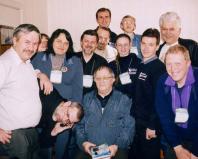End mills GOST 9304 69
GOST 9304-69*
(ST SEV 1175-78)
Group G23
STATE STANDARD OF THE USSR UNION
FACE MILLS
Types and main sizes
Shell End Mills. Types and Base Dimensions
Date of introduction 1970-01-01
Resolution of the Committee on Standards, Measures and measuring instruments under the Council of Ministers of the USSR dated March 14, 1969 N 372, the implementation period was set from 01/01/70.
INSTEAD GOST 9304-59
* REISSUE (January 1993) with Amendments N, approved in September 1980, February 1981 (IUS 11-80, 4-81).
1a. The standard fully complies with ST SEV 1175-78.
(Introduced additionally, Amendment No. 2).
1. Milling cutters should be made of two types:
1 - face milling cutters with small teeth (Fig. 1 and 2 and Table 1);
2 - end mills with large teeth (Fig. 3 and Table 2).
2. The main dimensions of the cutters must correspond to those indicated in Figures 1-3 and in Tables 1 and 2.
Basic dimensions of cutters. Type 1. Milling cutters with a diameter of 40 to 50 mm, mounted on a longitudinal key
Type 1
a) Milling cutters with a diameter of 40 to 50 mm with fastening on a longitudinal key
Basic dimensions of cutters. Type 1. Milling cutters with a diameter from 63 to 100 mm with mounting on an end key
b) Milling cutters with a diameter from 63 to 100 mm with mounting on an end key
Table 1
Dimensions, mm
Designation | Applicability | Designation | Applicability | Number of teeth |
|||||
Right-wing | Left-handed | ||||||||
Example symbol milling cutters type 1, right-hand cutting, diameter 50 mm:
Milling cutter 2210-0063 GOST 9304-69
The same, left-handed:
Milling cutter 2210-0064 GOST 9304-69
Basic dimensions of cutters. Type 2
Type 2
table 2
Dimensions, mm
Designation | Applicability | Designation | Applicability | Number of teeth |
|||||
Right-wing | Left-handed | ||||||||
Note. Dimensions ; ; and (Fig. 1-3) - according to the appendix to this standard.
At the customer's request, cutters with a diameter of 80 mm can be manufactured with a bore hole diameter of 27 mm.
(Changed edition, Amendment No. 1, 2).
An example of a symbol for a type 2 cutter, right-handed, 63 mm in diameter:
Milling cutter 2210-0081 GOST 9304-69
The same, left-handed:
Milling cutter 2210-0082 GOST 9304-69
3. By agreement with the consumer, cutters with large teeth can be manufactured with an uneven circumferential tooth pitch.
4. For cutters manufactured centrally, the following are installed:
a) front angle in normal section to cutting edge:
on the cylinder 15°;
at the end 12°;
b) clearance angle in the section perpendicular to the axis of the cutter on the cylinder, 14°;
c) clearance angle in the section perpendicular to the cutting edge at the end, 8°;
d) angle of inclination of chip flutes:
25-30° - for type 1 cutters; 35-40° - for type 2 cutters.
5. The cutters are manufactured by right-hand cutting machines. Left-handed cutters are manufactured according to customer requirements.
6. Dimensions of the keyway for longitudinal and end keys - according to GOST 9472-90.
7. Technical requirements- according to GOST 1695-80.
8. It is allowed, at the customer’s request, to produce cutters with the main dimensions specified in Appendix 2.
(Introduced additionally, Amendment No. 2).
ANNEX 1
Type 1 cutters | Type 2 cutters |
|||||||
on the cylinder | at the end | on the cylinder | at the end |
|||||
APPENDIX 2 (mandatory). Permissible main dimensions of cutters manufactured at customer's request
APPENDIX 2
Mandatory
no less |
||||
(Introduced additionally, Amendment No. 1).
Electronic document text
prepared by Kodeks JSC and verified against:
official publication
M.: Standards Publishing House, 1993
Put into effect by Resolution of the Committee of Standards, Measures and Measuring Instruments under the Council of Ministers of the USSR dated March 14, 1969 N 372
State standard USSR GOST 9304-69* (ST SEV 1175-78)
"BASED END MILLS. TYPES AND MAIN DIMENSIONS"
Shell end mills. Types and base dimensions
Instead of GOST 9304-59
1a. The standard fully complies with ST SEV 1175-78.
1. Milling cutters should be made of two types:
1 - face milling cutters with small teeth (drawings 1 and 2 and table 1);
2 - end mills with large teeth (Fig. 3 and Table 2).
2. The main dimensions of the cutters must correspond to those indicated in the drawing. 1-3 and in table. 1 and 2.
Type 1
a) Milling cutters with a diameter of 40 to 50 mm with fastening on a longitudinal key
b) Milling cutters with a diameter from 63 to 100 mm with mounting on an end key

Table 1
Dimensions, mm
|
Designation |
Applicability |
Designation |
Applicability |
Number of teeth |
|||||
|
Right-wing |
Left-handed |
||||||||
An example of a symbol for a milling cutter of type 1, right-hand cutting, with a diameter of D = 50 mm:
Mill 2210-0063 GOST 9304-69
The same, left-handed:
Mill 2210-0064 GOST 9304-69
Type 2

table 2
Dimensions, mm
Note. Dimensions h; h_t; r and r_t (Fig. 1-3) - according to the appendix to this standard.
At the consumer's request, cutters with a diameter of D=80 mm can be manufactured with a bore diameter of d=27 mm.
(Changed edition, Amendment No. 1, 2).
An example of a symbol for a type 2 cutter, right-handed, with a diameter of D = 63 mm:
Mill 2210-0081 GOST 9304-69
The same, left-handed:
Mill 2210-0082 GOST 9304-69
3. By agreement with the consumer, cutters with large teeth can be manufactured with an uneven circumferential tooth pitch.
4. For cutters manufactured centrally, the following are installed:
a) rake angle in normal section to the cutting edge:
on the cylinder gamma_n = 15°;
at the end gamma_t = 12°;
b) clearance angle in the section perpendicular to the axis of the cutter on the cylinder, alpha = 14°;
c) clearance angle in the section perpendicular to the cutting edge at the end, alpha_1 = 8°;
d) angle of inclination of chip flutes omega:
25-30° - for type 1 cutters; 35-40° - for type 2 cutters.
5. The cutters are manufactured by right-hand cutting machines. Left-handed cutters are manufactured according to customer requirements.
6. Dimensions of the keyway for longitudinal and end keys - according to GOST 9472-90.
7. Technical requirements - according to GOST 1695-80.
8. It is allowed, at the customer’s request, to produce cutters with the main dimensions specified in Appendix 2.
(Introduced additionally, Amendment No. 2).
Type 2 cutters
on the cylinder
on the cylinder
Appendix 2
Mandatory
Permissible main dimensions of cutters manufactured at customer's request
(Introduced additionally, Amendment No. 1).
Official publication
USSR STATE COMMITTEE ON STANDARDS
UDC 621.914.22: 006.354 Group G23
STATE STANDARD OF THE USSR UNION
FACE MILLS
Types and main sizes
Shell End Mills.
Types and Base Dimensions
Resolution of the Committee of Standards, Measures and Measuring Instruments under the Council of Ministers of the USSR dated March 14, 1969 No. 372 established the introduction date
from 01.01. 1970
Failure to comply with the standard is punishable by law
1. Milling cutters should be made of two types:
1 - face milling cutters with small teeth (Fig. 1 and 2 and
2 - face milling cutters with large teeth (Fig. 3 and
2. The main dimensions of the cutters must correspond to those indicated in the drawing. 1-3 and in table. 1 and 2.
b) Milling cutters with a diameter from 63 to 100 mm with mounting on an end key
|
Dimensions in mm |
|||||||||||||||||||||||||||||||||||||||||||||||||||||||||||||||
|
|||||||||||||||||||||||||||||||||||||||||||||||||||||||||||||||
|
Crap. 3 Dimensions in mm table 2 |
|||||||||||||||||||||||||||||||||||||||||||||||||
|
|||||||||||||||||||||||||||||||||||||||||||||||||
|
Note Dimensions h\ /z T ; g and g t (drawings 1-3) - according to the appendix to this standard. An example of a symbol for a type 2 cutter, right-handed, with a diameter of D = 63 mm: |
|||||||||||||||||||||||||||||||||||||||||||||||||
3. By agreement with the consumer, cutters with large teeth can be manufactured with an uneven circumferential tooth pitch.
4. For cutters manufactured centrally, the following are installed:
a) rake angle in the normal section to the cutting edge: on the cylinder at n = 15°;
at the end at t = 12°;
b) clearance angle in the section perpendicular to the axis of the cutter on the cylinder, a = 14°;
c) clearance angle in the section perpendicular to the cutting edge at the end, ai = 8°;
d) angle of inclination of chip flutes with:
25-30° - for type 1 cutters; 35-40° - for type 2 cutters.
5. The cutters are manufactured by right-hand cutting machines. Left-handed cutters are manufactured according to customer requirements.
6. Dimensions of the keyway for longitudinal and end keys - according to GOST 9472-70.
7. Technical requirements - according to GOST 1695-67.
|
Type 1 cutters |
Type 2 cutters |
|||||||
|
on the cylinder |
on the cylinder | |||||||
Editor S. F. Vilkina Technical editor F. I. Shreibshpip Proofreader V. L. Ryaukaite
Delivered to the embankment 21 04 80 Podl in the oven O 1 "0 80 0 5 p l 0.32 academic publication Tier 0000 Price 3 kopecks
Order "Badge of Honor" Publishing house of standards Moscow, D-557 Novopresp°nskii lane 3 Vilnius type traLnya Publishing house of standards, ul. M'nda>go, 12/14 Zak 2363
c, APPENDIX 2 Mandatory
Permissible main dimensions of cutters manufactured at customer's request
|
|
||||||||||||||||||||
|
(IUS Kt 4 1981) |
||||||||||||||||||||
|
BASIC SI UNITS |
|||||||||||||||||||||||||||||||||||||||||||||||||||||
|
|||||||||||||||||||||||||||||||||||||||||||||||||||||
|
DERIVATIVE UNITS WITH AND, HAVING PROPER NAMES |
||||||||||||||||||||||||||||||||||||||||||||||||||||||||||||||||||||||||||||||||||||||||||||||
|
||||||||||||||||||||||||||||||||||||||||||||||||||||||||||||||||||||||||||||||||||||||||||||||
|
* These two expressions include, along with the basic SI units, additional The unit is steradian. |
||||||||||||||||||||||||||||||||||||||||||||||||||||||||||||||||||||||||||||||||||||||||||||||
GOST 9304-69*
(ST SEV 1175-78)
Group G23
STATE STANDARD OF THE USSR UNION
FACE MILLS
Types and main sizes
Shell End Mills. Types and Base Dimensions
Date of introduction 1970-01-01
By Resolution of the Committee of Standards, Measures and Measuring Instruments under the Council of Ministers of the USSR dated March 14, 1969 N 372, the introduction date was set from 01/01/70.
INSTEAD GOST 9304-59
* REISSUE (January 1993) with Amendments N, approved in September 1980, February 1981 (IUS 11-80, 4-81).
1a. The standard fully complies with ST SEV 1175-78.
(Introduced additionally, Amendment No. 2).
1. Milling cutters should be made of two types:
1 - face milling cutters with small teeth (Fig. 1 and 2 and Table 1);
2 - end mills with large teeth (Fig. 3 and Table 2).
2. The main dimensions of the cutters must correspond to those indicated in Figures 1-3 and in Tables 1 and 2.
Basic dimensions of cutters. Type 1. Milling cutters with a diameter of 40 to 50 mm, mounted on a longitudinal key
Type 1
a) Milling cutters with a diameter of 40 to 50 mm with fastening on a longitudinal key
Basic dimensions of cutters. Type 1. Milling cutters with a diameter from 63 to 100 mm with mounting on an end key
b) Milling cutters with a diameter from 63 to 100 mm with mounting on an end key
Table 1
Dimensions, mm
Designation | Applicability | Designation | Applicability | Number of teeth |
|||||
Right-wing | Left-handed | ||||||||
An example of a symbol for a type 1 cutter, right-handed, 50 mm in diameter:
Milling cutter 2210-0063 GOST 9304-69
The same, left-handed:
Milling cutter 2210-0064 GOST 9304-69
Basic dimensions of cutters. Type 2
Type 2
table 2
Dimensions, mm
Designation | Applicability | Designation | Applicability | Number of teeth |
|||||
Right-wing | Left-handed | ||||||||
Note. Dimensions ; ; and (Fig. 1-3) - according to the appendix to this standard.
At the customer's request, cutters with a diameter of 80 mm can be manufactured with a bore hole diameter of 27 mm.
(Changed edition, Amendment No. 1, 2).
An example of a symbol for a type 2 cutter, right-handed, 63 mm in diameter:
Milling cutter 2210-0081 GOST 9304-69
The same, left-handed:
Milling cutter 2210-0082 GOST 9304-69
3. By agreement with the consumer, cutters with large teeth can be manufactured with an uneven circumferential tooth pitch.
4. For cutters manufactured centrally, the following are installed:
a) rake angle in normal section to the cutting edge:
on the cylinder 15°;
at the end 12°;
b) clearance angle in the section perpendicular to the axis of the cutter on the cylinder, 14°;
c) clearance angle in the section perpendicular to the cutting edge at the end, 8°;
d) angle of inclination of chip flutes:
25-30° - for type 1 cutters; 35-40° - for type 2 cutters.
5. The cutters are manufactured by right-hand cutting machines. Left-handed cutters are manufactured according to customer requirements.
6. Dimensions of the keyway for longitudinal and end keys - according to GOST 9472-90.
7. Technical requirements - according to GOST 1695-80.
8. It is allowed, at the customer’s request, to produce cutters with the main dimensions specified in Appendix 2.
(Introduced additionally, Amendment No. 2).
ANNEX 1
Type 1 cutters | Type 2 cutters |
|||||||
on the cylinder | at the end | on the cylinder | at the end |
|||||
APPENDIX 2 (mandatory). Permissible main dimensions of cutters manufactured at customer's request
APPENDIX 2
Mandatory
no less |
||||
(Introduced additionally, Amendment No. 1).
Electronic document text
prepared by Kodeks JSC and verified against:
official publication
M.: Standards Publishing House, 1993




